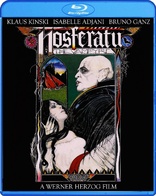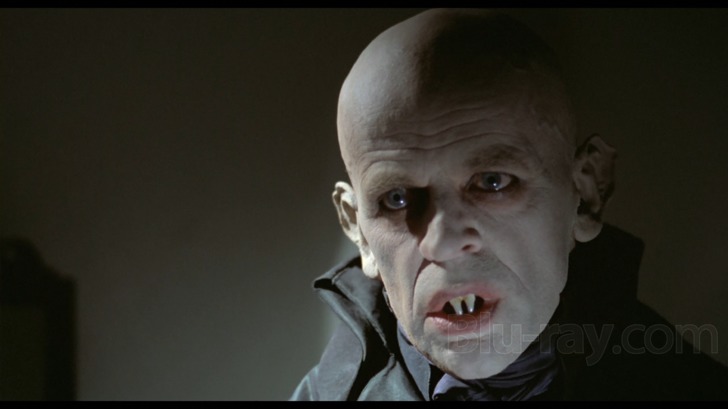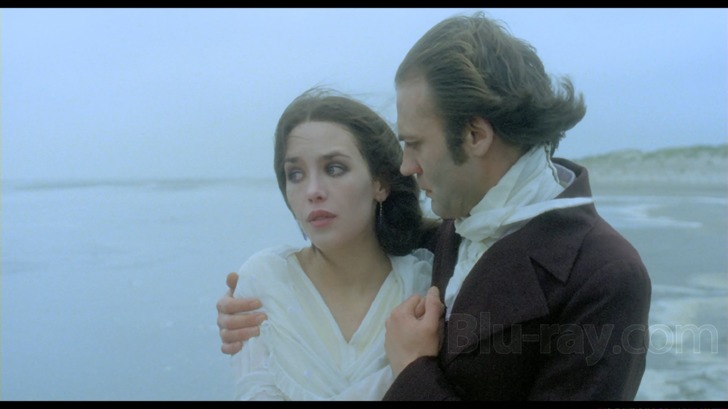Nosferatu the Vampyre Blu-ray Movie
HomeNosferatu the Vampyre Blu-ray Movie 
Nosferatu: Phantom der NachtShout Factory | 1979 | 1 Movie, 2 Cuts | 107 min | Rated PG | May 20, 2014

Movie rating
7.6 | / 10 |
Blu-ray rating
| Users | 3.5 | |
| Reviewer | 3.5 | |
| Overall | 3.5 |
Overview
Nosferatu the Vampyre (1979)
It is 1850 in the beautiful, perfectly-kept town of Wismar. Jonathan Harker is about to leave on a long journey over the Carpathian Mountains to finalize real estate arrangements with a wealthy nobleman. His wife, Lucy, begs him not to go and is troubled by a strong premonition of danger. Despite her warnings, Jonathan arrives four weeks later at a large, gloomy castle. Out of the mist appears a pale, wraith-like figure with a shaven head and deep-sunken eyes who identifies himself as Count Dracula. The events that transpire slowly convince Harker that he is in the presence of a vampyre. What he doesn't know is the magnitude of danger he, his wife and his town are about to experience.
Starring: Klaus Kinski, Isabelle Adjani, Bruno Ganz, Roland Topor, Walter LadengastDirector: Werner Herzog
| Foreign | 100% |
| Horror | 57% |
Specifications
Video
Video codec: MPEG-4 AVC
Video resolution: 1080p
Aspect ratio: 1.85:1
Original aspect ratio: 1.85:1
Audio
German: DTS-HD Master Audio 5.1
German: DTS-HD Master Audio 2.0
English: DTS-HD Master Audio 2.0
Subtitles
English
Discs
50GB Blu-ray Disc
Single disc (1 BD)
Playback
Region A (locked)
Review
Rating summary
| Movie | 4.5 | |
| Video | 3.0 | |
| Audio | 4.0 | |
| Extras | 3.0 | |
| Overall | 3.5 |
Nosferatu the Vampyre Blu-ray Movie Review
Dracula has a nonexistential crisis.
Reviewed by Jeffrey Kauffman May 16, 2014Of all the innumerable fictional characters who have entertained audiences in various media through the centuries, guess which one has made it to film the most? Jesus? Heavens, no! Ebenezer Scrooge? Bah, humbug! Alice in Wonderland? Off with your head! No, it’s actually that lovable little Count from Translyvania, Dracula, a character so iconic that even those who haven’t even seen a vampire movie can recount large swaths of the legend. Bram Stoker’s source novel appeared in 1897, but ironically it was “other” vampires that first made it to the silver screen, as early as Vampire of the Coast in 1909. Various other film vampires rose from their various caskets with great regularity over the following years, but it was 1922’s F.W. Murnau film Nosferatu that really raised public interest in the genre. Nosferatu simply appropriated large segments of Stoker’s conception whole cloth, to the point that the Stoker Estate sued the filmmakers, ultimately prevailing in court with the devastating judgment (at least for film preservationists) handed down that all copies of the film had to be destroyed. A mere handful of prints were saved from the scrap heap, and those in fact have provided the elements for the restorations of Murnau’s masterpiece which have appeared over the past couple of decades. Other vampires may have come and gone in the meantime, including of course the first “real” cinematic adaptation of Stoker’s (literally) immortal character, Dracula, but the horrifyingly nightmarish quality of Murnau’s formulation has retained an almost indelible imprint on both vampire lore in general as well as perhaps the collective unconscious. The pesky copyright issues that had befallen Murnau’s Nosferatu were no longer of any concern once the inimitable Werner Herzog decided to revisit Murnau’s film in 1979, with Herzog’s unlikely muse Klaus Kinski stepping in for the original’s Max Schreck. Rarely have a director and star been more perfectly suited for their material, but rarely have a director and star been less functional as a unit, as Herzog himself addresses in the two commentaries included on this new Blu-ray. Herzog’s films often have a dreamlike, hallucinatory quality, and that is perhaps first and foremost what sets his iteration of vampire lore apart from at least some of its undead kin. Herzog’s chief adornment of the general vampire legend is to make Count Dracula a rather sad, tragic character, one who really just wants a little company, but who can’t seem to help himself from transforming any potential companion into a zombiefied vampire acolyte. Kinski’s wide, penetrating eyes are excellent conduits for expressing a kind of inconsolable sorrow in the character, and the entire film plays out like a kind of fever dream where even a character as nefarious as Dracula can end up generating a little sympathy.

That dreamlike quality isn’t just alluded to in Nosferatu, it’s actually utilized overtly in a number of ways throughout the film, including the opening, which is in fact a nightmare that Lucy Harker (Isabelle Adjani) experiences. There are other fantasy or dream sequences that crop up throughout the film, and even scenes that are purely narrative in the “real” world can play like a vision from some astral realm. Part of this is surely due to the almost choreographed performance of Kinski, whose unexpectedly feline hand movements (replete with bizarrely long fingernails) make this Dracula decidedly different from Bela Lugosi’s suave continental. But there are other dreamlike stylistic moments Herzog exploits, like the long scenes of Jonathan Harker (Bruno Ganz) and Lucy at the beach, scenes which frequently don’t show either one of or both of their faces.
Herzog’s basic story follows Stoker’s relatively closely in the early going, with Harker setting off to finalize a real estate transaction with the mysterious Count Dracula (Klaus Kinski) in Transylvania. Harker interacts with some of the locals before making to the Count’s castle, at which point the real weirdness starts. Dracula is a bizarre, almost albino, character seeking to come to London, but Harker feels there’s something not quite right about things, especially once he figures out he’s a veritable prisoner and that the Count has unusual sleeping quarters.
The Count seems to already have a telepathic connection with Lucy, and that hallucinatory quality is part of what gives this particular Dracula retelling much of its power. Also aiding the mood immeasurably is Herzog’s very smart use of locations. Harker’s trek to the Count’s castle is incredibly scenic, if just slightly menacing, and later scenes like a now famous rat invasion off of a docked ship add a potent dose of fear and unease.
But it’s Herzog’s conception of the main character that ultimately sets this Dracula tale firmly apart from the rest. Dracula isn’t only a Freudian specimen in Herzog’s formulation, he’s also kind of ironically Nietzschean. This is a character who has in a way achieved the status of Übermensch, only to find it’s lonely with no real playmates. Herzog, obviously deeply influenced by Murnau (as he himself speaks about in the commentaries on this Blu-ray), gives a certain Abstract Expressionist tint to much of the proceedings, choosing some odd, skewed angles to help represent the living nightmare that is Dracula as both a character and a story.
Nosferatu the Vampyre Blu-ray Movie, Video Quality 

Nosferatu is presented on Blu-ray courtesy of Scream Factory (an imprint of Shout! Factory) with an AVC encoded
1080p transfer in 1.85:1. It's uncertain whether this is the same transfer used for the German Blu-ray release that came out about a year and a
half ago, but based on my colleague Dr. Svet Atanasov's review of that edition, if this isn't sourced from the same master,
it
certainly shows some of the same anomalies. While the image here is mostly very stable, with good, natural looking
colors
(with Herzog's mostly tamped down palette), there's been some obvious high frequency noise reduction here that has
had
an odd and somewhat differing effect on the film's grain structure. What struck me personally as the most unusual thing
here is how variable the denoising is. Watch, for example, early in the film when Harker and Lucy are saying
goodbye. The interior shot is virtually grain free, with the clean, textureless look of video. When the film cuts to the
outside
of the Harker home, things improve somewhat, with a kind of splotchy but at least evident recreation of a grain field.
Then,
however, the film cuts to a scene of a canal, and it almost looks like we're looking at 16mm, with quite heavy grain and a
really soft, blurry image. There is something akin to grain evident especially in the brighter outdoor scenes, but if you use
your
pause button to isolate individual moments, you'll see that it tends to appear only in clumps, with surrounding areas of a
completely scrubbed surface. Also cropping up with some fair regularity (again most noticeable in scenes with decent
lighting like the ones at the beach are noticeable compression artifacts. As Svet noted in his review of the German
edition,
the fact that the film is so dimly lit so much
of the time may make this less of an issue than it might otherwise be. On the plus side, contrast is generally excellent
and
blacks are solidly deep, giving the film's shrouded ambience a bit of moody pop.
Note: Screenshots 1-10 are from the English version, and screenshots 11-19 are from the German version.
Nosferatu the Vampyre Blu-ray Movie, Audio Quality 

Both the German and English language versions of the film are presented on this Blu-ray disc, with the German version being granted both a DTS-HD Master Audio 5.1 and DTS-HD Master Audio 2.0 mix, with the English version being offered only in DTS-HD Master Audio 2.0. There are some slightly phasing issues on the English track that are especially noticeable in moments like Lucy's terrified scream that opens the film, but generally dialogue, score and effects come through quite cleanly and clearly. No such issues afflict either German track, but I personally preferred the DTS-HD Master Audio 2.0 mix, for to my ears it offered a much more intimate accounting of the dialogue. While the 5.1 mix does open up some of the effects and especially the moody score, dialogue seems slightly anemic when compared to the 2.0 iteration. Fidelity on both of these tracks is generally excellent, though it seems like amplitude has been just subtly boosted on the 2.0 mix.
Nosferatu the Vampyre Blu-ray Movie, Special Features and Extras 

- German (1080p; 1:46:45) and English (1080p; 1:47:01) Versions
- Making of Nosferatu (1080p; 13:06) is a vintage featurette with good Herzog interviews and lots of behind the scenes footage.
- Trailers (1080p; 6:47)
- Still Gallery (1080p; 3:06)
- English Commentary with Werner Herzog is only available on the German version of the film. He's quite informative, as he always is, detailing everything from how he got the rats in the famous rat scene to some of his battles with Kinski.
- German Commentary with Werner Herzog (Subtitled) is similarly available only on the German version. Moderated by Laurens Straub, this is the same commentary that has graced previous releases of Nosferatu.
Nosferatu the Vampyre Blu-ray Movie, Overall Score and Recommendation 

If you're looking for a Dracula tale that has an almost subliminally hypnotic power, look no further than Werner Herzog's Nosferatu. Beautifully filmed and almost archetypically performed by Klaus Kinski, this is the Dracula of the deepest subconscious. This Shout! release has some of the same video issues that afflicted the German release, so fans may want to wait to see what the BFI version has to offer.
Similar titles
Similar titles you might also like

Nosferatu
Nosferatu, a Symphony of Horror | Nosferatu, eine Symphonie des Grauens | 2006 Restoration, Hans Erdmann/Heller compilation score
1922

Woyzeck
1979

Ballad of the Little Soldier
Ballade vom kleinen Soldaten
1984

Land of Silence and Darkness
Land des Schweigens und der Dunkelheit
1971

The Enigma of Kaspar Hauser
Jeder für sich und Gott gegen alle
1974

Heart of Glass
Herz aus Glas
1976

Where the Green Ants Dream
Wo die grünen Ameisen träumen
1984

Even Dwarfs Started Small
Auch Zwerge haben klein angefangen
1970

My Best Fiend
Mein liebster Feind - Klaus Kinski
1999

Fata Morgana
1971

Huie's Sermon
1981

God's Angry Man
1981

Cobra Verde
1987

Stroszek
1977

Cronos
1993

Vampyr
1932

Lessons of Darkness
Lektionen in Finsternis
1992

Black Sabbath
AIP Cut | 60th Anniversary
1963

Dark Waters
Temnye vody
1993

REC 4: Apocalypse
[•REC]⁴: Apocalypse / [•REC]⁴: Apocalipsis
2014